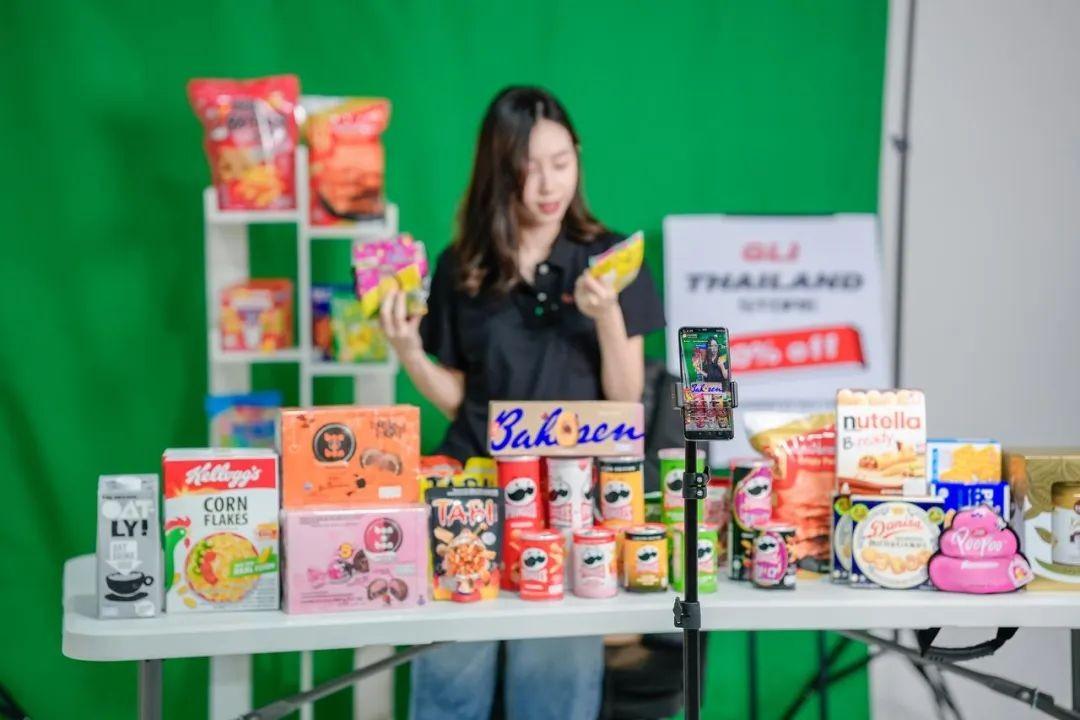GMV grows tenfold! Live streaming e-commerce finds the second paradise 丨 Insights into Southeast Asia

By Zhou Xinyi
Edited by He Yang
【Ebrun Original】As of the beginning of 2024, a new policy aimed at the development of e-commerce officially took effect in Thailand.
The Thai tax office requires online platforms to set up dedicated accounts and transmit income information of operators to the tax authorities in accordance with the stipulated standards
"This will help them to check the actual income of local and foreign sellers on the platform, and it does not rule out the possibility of taxation on foreign merchants selling products in Thailand in the future, to ensure a more fair competition environment for taxed Thai merchants." Many e-commerce operators in Southeast Asia have pointed out, similar scenarios have occurred in other Southeast Asian countries such as Indonesia and Malaysia
In other words, foreign merchants who sell goods in Thailand through cross-border e-commerce platforms may no longer enjoy the hidden tax cost advantages, thereby reducing the competitiveness of product prices
"Can the Thai market still thrive?" Doubts have begun to haunt the minds of many Chinese cross-border sellers
In recent years, the growth potential of emerging e-commerce markets in Southeast Asia has continued to be unlocked. Indonesia, Thailand, Vietnam and other places are popular destinations for Chinese merchants to go cross-border. The short video and live shopping trend sparked by TikTok has not only provided new business opportunities for a large number of local small and medium-sized enterprises and individual entrepreneurs, but also attracted a group of Chinese merchants to come
In October 2023, TikTok Shop Indonesia was forced to close due to new regulations from the regulatory authorities, becoming a major variable. This has added a lot of uncertainty to the entire Southeast Asian market, causing anxiety for many striving merchants
A phenomenon is that, amidst the wind turmoil in Indonesia, many cross-border sellers have chosen Thailand as a relocation destination
"Last November, many people contacted us for shipments, most of them were transferred from Indonesia." Vincent, head of Thai MCN agency GLI, described to Ebrun the impact of the prior closure of TikTok Shop Indonesia site, "a batch of goods in the warehouse, two batches on the road, one batch sent to the customers, and then suddenly the policy came down. These goods cannot be returned, they can only be either destroyed or sold to other platforms or countries."
In his view, Indonesia's new policies (including separating social media from e-commerce, and imposing a 10% tax on low-priced imported products sold by e-commerce), Malaysia's collection of taxes on low-priced imported goods sold online, and problems with the logistics infrastructure in the Philippines, along with the tightening of e-commerce policies in Vietnam, will all affect a large number of sellers' livelihood in a variety of ways. In the volatile Southeast Asia, Thailand, with its relatively lax business environment, is a treasure trove
Thailand is the second largest economy in Southeast Asia and has a population of over 70 million. At the same time, Thailand is the second largest e-commerce market in Southeast Asia. According to the 2023 Southeast Asia Internet Report jointly released by Google, Temasek, and Bain, Indonesia's e-commerce GMV was approximately $62 billion in 2023, while Thailand's figure was around $22 billion, Vietnam, the Philippines and Malaysia are all around the $10 billion range, and Singapore is about $8 billion
Last year, the leading platforms Shopee and Lazada in Thailand raised their commission rates and platform service fees, and with the rapid growth of TikTok, the market is set to see another wave. Coupled with the possible variables brought about by the new policies, the tranquility here may be gone forever, and for a time, both opportunities and risks are surging secretly

01
The big battlefield of social media
The big hotbed of e-commerce
Compared with other Southeast Asian countries, Thailand's e-commerce has always been favored by many Chinese sellers
In 2020, Vincent, a Thai Chinese who was still engaged in the overseas warehousing business, saw the number of merchants entering his warehouse and the 8,000-square-meter warehouse gradually filled with various types of goods, which made him realize the potential of Southeast Asian e-commerce for the first time
That year, Shopee became the top e-commerce platform in Thailand. Vincent cooperated with a leading MCN agency in Thailand to carry out cross-border e-commerce projects, with Vincent responsible for the venue and warehouse, while the MCN agency was responsible for helping Shopee merchants with operations. Among his serviced clientele, there emerged one store after another with a daily average sales volume exceeding ten thousand
However, the dividend period came and went quickly. By 2022, e-commerce platforms that had undergone rapid growth began to tighten their policies. In the face of increasingly fierce competition from the supply side and the soaring cost of traffic, many small vendors found it difficult to continue, and had to close their stores. "Many customers do not want to continue to pay warehousing fees. They chose to directly abandon the goods, which led to various categories of inventory piling up," Vincent would often lament at the sight of the accumulated goods
However, in this predicament, Vincent's business turned a corner again, unwittingly seizing the second wave of e-commerce dividend in Thailand—to clear these inventories, start short video shopping and live streaming on TikTok
"At that time, when the product link went up, videos were played with a natural flow of 30,000 to 50,000." He recollected

Since the launch of its e-commerce business in Thailand in the first half of 2022, TikTok has grown rapidly. A report by data analysis firm Momentum Works shows that in 2022, TikTok e-commerce accounted for 4% of the total GMV of the $14.4 billion e-commerce market in Thailand, or about $576 million. It's also been reported that as of December 2023, TikTok's e-commerce GMV in Southeast Asia exceeded $13 billion, with Indonesia breaking $4 billion and Thailand reaching around $3.5 billion
Official data from TikTok Shop shows that during the 2023 Southeast Asia cross-border 11.11 promotion, the GMV reached a nearly 10-fold year-on-year increase in Thailand, ranking first among the five Southeast Asian sites, while Vietnam's GMV growth reached 8 times, and Malaysia and the Philippines reached 3 times, and Singapore reached 2 times
According to data from FastMoss, in the 2023 Global Top 20 TikTok Shop sales, the number of shops from Thailand accounted for the most, amounting to 35%. Among them, the smartphone and digital product Orsen&Eloop Thailand from the Thailand site entered the top 3 in the 2023 Global Top 20 TikTok Shop sales
The explosion of TikTok e-commerce in Thailand was not accidental. In Thailand, the internet penetration rate has exceeded 80% and social media channels such as Instagram, Facebook and Line are all flourishing. Facebook is equivalent to the local WeChat. As a result, brand advertising mainly focuses on social media, and platform e-commerce also needs to rely on social media to drive traffic. Many merchants will choose to sell products directly through social media channels
"Because the development of social platforms actually preceded e-commerce platforms. The first batch of social e-commerce sellers were more often husband-and-wife shop owners or owners of wholesale markets, gradually helping users form the mindset of placing orders through social channels," said the head of a Southeast Asian social e-commerce platform to Ebrun
Instagram, Facebook, and other social media e-commerce infrastructure are not fully equipped and do not provide basic facilities such as shelves, payments, and fulfillment. This has brought some entrepreneurial opportunities for local social e-commerce. Local social e-commerce platforms will act as conversion platforms, connecting local small-scale distributors with the upstream supply chain. (For more content on Southeast Asian social e-commerce, see "No Pinduoduo or WeChat, but 'WeChat merchants' achieved $50 billion in Southeast Asia in one year | Deep Insights into Southeast Asia Outbound")
At the same time, Thailand's entertainment industry is well developed, with a very active live streaming industry and a sufficient supply of anchors. Before the launch of TikTok Shop, live streaming in Thailand was more focused on entertainment, with platforms such as Bigo Live, StarMe, Nonolive, and other entertainment live broadcast platforms being very active. Although e-commerce platforms such as Lazada and Shopee have opened live delivery channels, they have yet to ignite a live delivery trend. With the arrival of TikTok Shop, which has social media origins and a complete e-commerce transaction chain, this undoubtedly further catalyzed the development of live streaming e-commerce.
The ecologies of Thailand's MCN institutions, which were originally centered around Facebook, Instagram, and other veteran social media platforms, are gradually becoming more diverse. A large number of emerging players with TikTok live delivery as their main business, such as Ma Go and GLI, have risen to prominence, and many have backgrounds in China.
Kulthirath Pakawachkrilers, Chairman of the Thai E-Commerce Association, stated that live streaming e-commerce accounts for 38% of Thailand's social media market value, and the commercial value of Thai live streaming is expected to reach 121 billion baht (approximately 24.5 billion RMB) in 2025.
Following the impact of TikTok Shop in Indonesia, the potential and importance of Thailand as the second-largest market for TikTok e-commerce in Southeast Asia have become increasingly prominent.
Vincent frankly stated that he does not worry about major changes in Thai official policies: “Whether it is the increasingly close relationship between China and Thailand (such as the mutual visa exemption between China and Thailand), or TikTok's relationship with the local government (such as TikTok's collaboration with the Tourism Authority of Thailand announced in January to expand creative content creation strategies to attract global audiences through organizing Thailand's soft power X Guinness World Record Challenge), I believe that TikTok Shop's development in Thailand is positive.”

TikTok has 41 million users in Thailand, with a penetration rate as high as 70.4%.
Source: FastMoss "2023 TikTok Ecology White Paper"
02
The end of e-commerce shelf dividends
Lowering the threshold for live delivery
In Thailand, traditional shelf e-commerce represented by Shopee and Lazada has undergone many years of development, with the landscape of sellers gradually stabilizing, and the platform's focus is quietly changing.
According to the Bangkok Post, in 2022, the Thai e-commerce platforms Shopee and Lazada both turned a profit. Shopee's revenue reached 21.7 billion baht (approximately 4.3 billion RMB) and a profit of 2.4 billion baht; Lazada's revenue reached 20 billion baht (approximately 4 billion RMB) and a profit of 413 million baht.
Shopee's senior merchant, Da Hong, pointed out: "A few years ago, in order to compete for market share, both Shopee and Lazada offered crazy subsidies and promotions, which went very 'viral.' But last year, it was obvious that the approach was different from previous years. Both Shopee and Lazada have gradually increased their commissions and platform service fees, and are gradually shifting towards profitability. For sellers, this also means the end of the dividend period."
"During the years of 'burning money' competition in e-commerce platforms, there were traffic dividends, where there was natural traffic as soon as the product was listed. Now, you must pay for advertising and keywords. Secondly, there were policy benefits; there were various subsidies for commissions and logistics. However, in the past two to three years, as the platforms approach the end of the dividend years, operating costs have continued to rise. Coupled with the increasingly severe price wars among Thai sellers, considering everything, the profit from the same order volume has reduced significantly." Da Hong said.
He mentioned that as profit margins contracted, sellers tended to "save expenses" at all levels. For example, many cross-border sellers in the Thai market have established their own overseas warehouses. Some even open overseas warehousing services to small and medium-sized sellers, thereby using economies of scale to compress the costs of logistics warehousing links.
However, building an overseas warehouse in Thailand is not that easy. The first hurdle is registering a company. Joan, an e-commerce merchant, went to Thailand to build an overseas warehouse in June last year. She explained: "For a foreigner to register a Thai company, they have to either partner with a Thai person they know or find a local lawyer or accounting firm to handle it." This stems from specific restrictions in Thai law on foreign investment—companies incorporated locally in Thailand must have a Thai shareholder holding over 51% of the shares.
The second hurdle is frequent inspections of overseas warehouses. "Protection fees need to be paid when establishing a warehouse locally." As the volume of goods steadily increased, Joan's warehouse saw a group of inspectors, "They came with the courier and checked business licenses, tax situations, passports, employment, and so on. Carelessness would result in fines."
In the past six months, Joan has deeply felt that her profit space has shrunk, either facing peer price competition or the official launch of an official overseas warehouse by the platform. "Many friends who have been in the overseas warehousing business in Thailand have made the transition to the live broadcasting business."
There is no doubt that TikTok is the destination for these live streaming gold diggers.

In the past, Shopee and Lazada, the mainstays of Thailand's e-commerce market, each had their own niches—Shopee focused on low prices and Lazada focused on branding. However, the rise of TikTok has broken this relatively static situation, tearing down its defenses with the format of live delivery.
"It's true that a lot of those who initially prospected on Shopee and Lazada have left, and new sellers have flooded into TikTok," Vincent pointed out. He predicted that the first batch of Thai yellow cars furiously promoted by TikTok did not exceed 200 stores, but has now grown to over ten thousand stores.
"The Thai short video shopping scene is very hot, and the live streaming delivery talent ecology is still under development. A large number of TikTok MCN institutions have emerged in the market. However, unlike in China, due to a lack of supply chain resources and brand operations experience, there are relatively few talents operating self-owned brands, with most using their image rights for product packaging outsourcing." Vincent said.
The vigorous development of TikTok's live streaming is driving the current surge in Thailand's live streaming e-commerce industry, while also exerting pressure on downstream sellers. Last year, TikTok Shop Thailand stores were required to meet a certain number of live stream sessions—70 per month—and each live stream session had to last at least 4 hours. Additionally, live stream data had to grow by 30% each month. If the task was not completed, a fee of 12 baht (approximately 2.45 RMB) would be deducted per order.
“Since January 1 this year, the task has been cancelled,” said Vincen, “Previously, TikTok's threshold was too high, whether it was for ordinary sellers or MCN agencies, it was difficult to complete the task without a live streaming team or cooperation with talent agencies. If the daily average of ten thousand orders is not completed, more than 20,000 yuan in fees will be deducted.”
At present, the average number of online viewers in the top live broadcast rooms on TikTok Thailand is in the thousands, and the peak number of people exceeds ten thousand. The top KOL fans number around 10 million. One fact is that Thailand is still dominated by Internet celebrity marketing. Although live streaming for sales is developing rapidly, it has not yet become the dominant force in the market both in Thailand and throughout Southeast Asia.
03
Offline is an Inevitable Battlefield
In October 2023, ANTA, a leading Chinese sportswear company that has been selling through online channels in Thailand, opened its first exclusive store in Siam Paragon, Bangkok.
"Retail in Thailand cannot do without offline channels, with offline markets accounting for over 80% of the retail market in Thailand. At the same time, the recovery of the tourism industry will further promote the growth of offline retail." Vincent pointed out.

Frank Guo, CEO of Fanslink, a cross border integrated marketing platform, likewise stated that offline channels are the true sign of a brand entering the Thai market. In the offline retail industry in Thailand, in addition to hypermarkets, there are also monopolistic convenience stores and supermarkets, as well as small mom-and-pop stores.
Fanslink has previously assisted Chinese brands such as Xiaomi, Ecovacs, and Delmar in entering the local Southeast Asian market. Its methodology is to first establish visibility online, then distribute products to small retailers through S2b2C, and finally, have these local retailers distribute the products.
Analysis by Grand View Capital also indicated that the modern retail market in Thailand is mainly dominated by the Central Group and Central Retail, and that hypermarkets are declining while convenience stores and supermarkets are on the rise. Central Retail's 7-Eleven stores in Thailand exceed 10,000 in number, and it is an exaggerated statement to say that there is a 7-Eleven wherever there are people.
The channel strategy of Dreame, a smart home appliance brand, in Thailand is a typical example. Since entering the Southeast Asian market at the end of 2021, Dreame has formed a dual-drive sales network from online to offline. Online, it has quickly opened the market and accumulated brand exposure through e-commerce and social media platforms such as Shopee, Lazada, and TikTok. In early summer of 2023, it opened its first brand store in Bangkok, Thailand, in the Southeast Asian region. Currently, Dreame's market share in the intelligent home appliance market in Thailand ranks among the top three.
The regional head of Dreame Technology's Southeast Asian market has stated: “We hope to build a virtuous cycle online and offline, focusing on experience and promoting the highlights and selling points of products online, achieving a mutually beneficial and harmonious state.”
Frank Guo also observed a notable change in the retail market in Thailand—previously, there was a prevalence of Japanese, Korean, European, and American brands, but in the last decade, Chinese brands have become active.

"Japanese and Korean companies often began their overseas expansion very early on because their domestic markets were too small, and their products and services were designed for the entire world at an early stage. Thailand is even one of the countries where many Japanese businesses put down their roots in the early years." This sentiment was echoed by entrepreneurs in Thailand.
As an example, in the automotive industry, Thailand was once dominated by Japanese automakers in the era of gasoline vehicles, but now, with the new energy wave, Chinese automakers are exerting an increasing influence on the local market. The presence of BYD new energy vehicles can be frequently seen on the streets of Thailand. Additionally, Thailand has also become the preferred destination for overseas investments from many Chinese electric vehicle companies, such as BYD, Great Wall Motors, SAIC, who are either establishing factories or acquiring existing ones in Thailand.
Of course, a large number of Chinese consumer brands are also entering the Thai market: Miniso has brought 15 baht (about 3 RMB) ice cream cones and 20 baht lemon water into many university cities, Miniso’s various co-branded IP products and products have firmly captured the attention of younger generations, and baotu.com brands such as 52TOYS, Pop Mart, and UR fast fashion brands have all appeared on the streets of Thailand..
“More and more Chinese brands are coming to Thailand, and local consumers are also establishing an awareness of these emerging brands,” Vincent also indicated, “Both online and offline, the gateway to the Thai market has always been open. There is no unprofitable market, nor is there a completely closed market, only dividends that have not been seized.”
[Copyright Notice] Ebrun advocates respecting and protecting intellectual property rights. Without permission, no one is allowed to copy, reproduce, or use the content of this website in any other way. If any copyright issues are found in the articles on this website, please provide copyright questions, identification, proof of copyright, contact information, etc. and send an email to run@ebrun.com. We will communicate and handle it in a timely manner.
